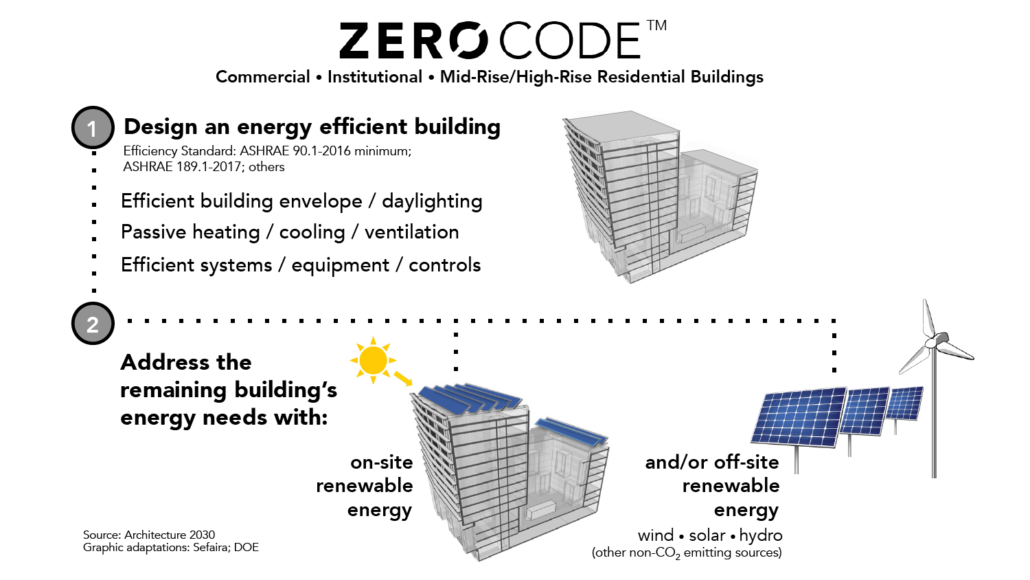FRAMEWORK
By 2060, the world is projected to add 230 billion m2 (2.5 trillion sq ft) of buildings, or an area equal to the entire current global building stock. This is the equivalent of adding an entire New York City to the planet every 34 days for the next 40 years.
While improvements in building sector energy efficiency and growth in renewable energy generating capacity is having an impact, it has not been nearly enough to amply offset the increase in emissions from new construction. Only by eliminating CO2 emissions from new building operations will we begin to significantly reduce building sector emissions before they are locked-in for the foreseeable future.

Achieving zero emissions from new construction will require energy efficient buildings that use no on-site fossil fuels and are 100% powered by on-site and/or off-site renewable energy.
Energy-efficient new construction ensures that total building energy demand is minimal, enabling carbon-free renewable energy sources to easily meet demand.
To meet this need, Architecture 2030 developed the ZERO Code, a national and international building energy standard for new building design and construction that integrates cost-effective energy efficiency standards with on-site and/or off-site renewable energy resulting in zero-net-carbon (ZNC) buildings.

Zero Emissions for New Construction Will Require:
Energy-Efficient New Construction
For jurisdictions that have not adopted current energy-efficient model building energy codes, adoption must be a priority and an essential part of their carbon reduction strategy since new buildings have a long-lasting impact on each jurisdiction’s energy consumption and emissions.
Adopting current model building energy codes have a number of advantages – they are evaluated to be cost effective, include ready-to-use compliance tools, and reduce occupant energy burdens, including those for low-income communities.
For jurisdictions where building energy codes are dictated by a higher body and do not meet the most current efficiency standards, the ZERO Code’s efficiency standard – ASHRAE 90.1 2016 or greater – can be adopted as a voluntary stretch-code coupled with both financial and non-financial incentives to promote participation, including jurisdictional tax credits and development benefits.
Jurisdictions with existing high-efficiency building energy codes should develop policies to ensure that all new construction is fully powered by carbon-free renewable energy and produce no on-site emissions.
ZERO Code – Energy Efficiency Standard
The ZERO Code – Energy Efficiency Standard is a building energy standard that includes both prescriptive and performance paths for building energy efficiency compliance (based on existing standards that are widely used by municipalities and building professionals worldwide), and is supported by compliance tools and simulation software.
Complying with the ZERO Code – Energy Efficiency Standard first entails meeting the minimum prescriptive or performance requirements for building energy efficiency defined by ASHRAE Standard 90.1-2016. As part of a standardized and predictable process to continue to advance energy efficiency, new versions of ASHRAE Standard 90.1 will be incorporated into the ZERO Code as they are developed. Also, more stringent standards such as the 2018 International Green Construction Code (IgCC) and ASHRAE Standard 189.1-2017 have been included in the ZERO Code. Newer versions of ASHRAE 90.1, 189.1 and the IGCC will also be incorporated as they are published. Once the ZERO Code – Energy Efficiency Standard is met, then the on-site and/or off-site renewable energy needed to achieve a zero-net-carbon building design can be calculated (access the ZERO Code Energy Calculator).
Why this strategy?
The ZERO Code – Energy Efficiency Standard provides adopting jurisdictions with the following advantages:
- utilizes ASHRAE 90.1-2016, as the national and international minimum energy efficiency standard
- supports energy efficiency upgrades every 3 years
- has been determined cost effective
- is supported by COMcheck
- is supported by energy modeling tools
- is supported by the ZERO Code Calculator
- together with the ZERO Code – Renewable Energy Standard, results in zero-net-carbon buildings
Carbon-Free Renewable Energy
New buildings must produce and/or procure all annual energy used for their building operations from carbon-free renewable energy sources.
While energy efficiency is the primary leverage point of the traditional building energy code structure, zero-emissions buildings cannot be achieved through efficiency alone. Energy efficiency must be complemented with carbon-free renewable energy generation and procurement in order to reach zero-emissions standards, especially in jurisdictions with existing energy efficient codes. Ensuring that the energy needs of new buildings are met by carbon-free renewable energy sources is one of the most impactful emissions mitigation strategies for new construction.
Many jurisdictions are promoting or requiring on-site renewable energy generation by local ordinances. The next step, and most impactful, will be off-site renewable energy procurement requirements, which address dense urban development and large buildings with limited on-site renewable energy generating capacity.
Providing tax credits, low-interest loans, density bonuses, rebates, fast-track permitting and other incentives for buildings to produce their own carbon-free renewable energy, and providing options for off-site procurement of carbon-free renewable energy within the context of codes, will accelerate and complement efforts by utilities and regional governments to decarbonize their electricity supply.
Jurisdictions with large amounts of carbon-free renewable energy in their electricity supply should adopt current energy-efficient model building energy codes so that carbon-free renewable energy sources to easily meet demand, as well as adopt all-electric new construction policies to take advantage of the carbon-free renewable energy sources.
ZERO Code – Renewable Energy Standard
The ZERO Code – Renewable Energy Standard offers code adaptable language and a flexible approach for incorporating renewable energy, both through on-site generation and/or off-site procurement.
By establishing a flexible approach, the ZERO Code is applicable to all new commercial and institutional buildings, and mid- to high-rise housing, including buildings with limited on-site renewable energy generating capacity (e.g. buildings in dense urban environments).
A Technical Support Document was also created that describes several potential options for off-site procurement of renewable energy within the context of codes, and presents a process for evaluating and assigning a weight to each procurement method. The feasibility/desirability of each option will vary depending on how electric systems are structured and the laws and regulations applicable to each city, state, province, country or local jurisdiction that adopts the ZERO Code – Renewable Energy Standard. It is anticipated that qualifying off-site renewable energy systems and their weightings will vary with each adoption of the ZERO Code – Renewable Energy Standard. The purpose of the Technical Support Document is to provide information to enable these adaptations.
Why this strategy?
The ZERO Code – Renewable Energy Standard provides adopting jurisdictions with the following advantages:
- can be implemented as a local ordinance
- can be decoupled from the Energy Efficiency Standard for jurisdictions that do not have control over their energy efficiency code
- is supported by the ZERO Code Calculator
- together with the ZERO Code – Energy Efficiency Standard, results in zero-net-carbon buildings
Highlighted Policy: California Solar for New Residential
Many jurisdictions are leveraging their building energy codes or local ordinances to lead to, or require, on-site renewable energy generation. For example, on-site solar requirements for new residential construction in the State of California are the first in the nation and will go into effect in 2020.
Zero On-Site Emissions
New construction must eliminate on-site fossil fuels by being fully electric, in conjunction with producing and/or procuring carbon-free renewable energy, and/or by sourcing carbon-free thermal energy.
On-site fossil fuels are a major energy source for heating buildings, and continue to be incorporated into new construction. While zero-net-carbon new construction can be achieved by offsetting on-site fossil fuel emissions with the procurement of carbon-free renewable energy (See ZERO Code), zero-emissions buildings do not have any emissions (on-site or off-site).
Jurisdictions can provide tax credits, low-interest loans, rebates, and other financial incentives for buildings designed to use no on-site fossil fuels, while they work to implement legislative requirements.
Jurisdictions with GHG-intensive electricity grids must complement all-electric new building policies with impactful mechanisms for carbon-free renewable energy generation and procurement to reach zero-emissions standards.
Jurisdictions with GHG-intensive electricity or district energy grids must complement switching to electric or district systems with impactful mechanisms for carbon-free renewable energy generation and procurement to reach zero-emissions standards.
Policy Precedents: New Construction
City of Vancouver Green Buildings Policy for Rezoning
Berkeley Prohibition of Natural Gas Infrastructure in New Buildings
Germany Renewable Energy Heat Act
California Solar for New Residential
San Francisco Better Roofs
Clean Energy D.C. Omnibus Act
Achieving Zero
Reaching a 50-65% carbon emissions reduction in the built environment by 2030, and zero emissions by 2040, is critical if we are to successfully manage climate change. Achieving Zero is a framework and set of tools to help city and sub-national governments (state, provincial, and regional) meet this target.
Contact
Architecture 2030
+1 (206) 438-3456
info@achieving-zero.org

